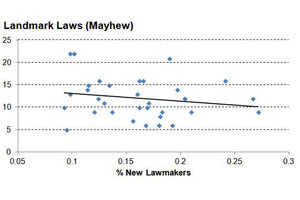Can midterms 'solve' Washington? Problems go much deeper than one election.
Even if Republican take control of the Senate and keep the House, Democrats will have many ways to stop their agenda. And polarization might only increase.

This chart shows that as the percentage of new lawmakers elected increased, the number of landmark laws passed declines.
Jordan Ragusa
An old adage is that lawmakers win reelection by “running against Washington.” According to a recent Gallup poll, just 14 percent of Americans approve of Congress’s job performance. So while there’s something absurd about incumbents and major party candidates running against themselves, it’s a winning strategy for sure.
In some ways Congress’s remarkably low approval is undeserved. We know, for example, that congressional approval fluctuates along with macroeconomic conditions. We also have an arrangement where both parties are sharing power, so everyone has a reason to hate at least half of Congress. Research even shows that the passage of legislation has a negative effect on approval (you know, when Congress actually does its job).
Nonetheless, in running against Washington, lawmakers regularly promise to “fix Congress,” work “collaboratively” with the other side, and “break the logjam” of legislation. Unfortunately, research suggests that none of these problems will be solved based on tonight’s midterm outcome. In fact, there are good reasons why some problems will get worse, not better.
Polarization
Let’s start with polarization, which is part and parcel to Congress’s dysfunction. For starters, polarization is a process whereby lawmakers in both parties move to the ideological extremes (leftward for Democrats, rightward for Republicans). And as a theoretical matter, that process can happen in two ways: either (1) new members enter Congress to the left or right of the lawmaker they replaced or (2) continuing members drift to the left or right over the course of their career.
Based on numerous studies, No. 1 is the larger cause of polarization. In other words, it’s the replacement of old members with new members that has caused Congress’s movement to the extremes.
In an old post (see here), I wrote about why the logic of “throwing the bums” out is wrong. If you read that article, the exact same logic applies here: If polarization is the “problem,” electing a large volume of “new lawmakers” will make things worse, not better.
Gridlock
Gridlock is defined as the inability of Congress to pass legislation. We can tackle the question of whether today’s midterm results can alleviate gridlock from multiple angles. I’m assuming that the House will remain in Republican hands (and extremely safe assumption), so the real question is what happens in the Senate (where current projections give anywhere from a 98 percent chance to a 70 percent chance).
For starters, it’s often assumed that “new members” will “break the logjam” and usher in a new era of collaboration and compromise. Unfortunately, the lessons of polarization apply here too: At best the volume of new members is unrelated to the passage of legislation and, at worst, new lawmakers make passing legislation harder. For those details, see here. But see the chart above comparing the percentage of new lawmakers elected (x-axis) and the number of landmark laws passed (y-axis).
Second, the fact that the House and Senate are controlled by rival parties is often cited as a reason for the current Congress’s gridlock. It is certainly logical that if Republicans win the Senate tonight, gridlock should go down. However this, too, is wrong.
Control of the Senate is what’s known as a “necessary but not sufficient” condition for breaking gridlock. While Republicans will indeed be better able to coordinate the passage of legislation across chambers, Democrats will retain two very powerful weapons that promote gridlock.
First, baring an upset of epic proportions, Democrats will maintain the ability to filibuster Republican proposals. Second, remember that President Obama has the power to veto any laws that survive a Democratic filibuster. I know that’s painfully obvious, but Republicans could circumvent the filibuster in two important ways: (1) by using a procedure known as “reconciliation” or (2) by eliminating the filibuster altogether. Both are very real possibilities, making Mr. Obama’s veto power that much more consequential. And according to these data, there have been 2,564 vetoes dating back to George Washington’s presidency. Among these, only 110 have been overridden by Congress, a success rate of just 4 percent.
But also, there is empirical research exploring these very questions. In a paper published in the American Political Science Review, Sarah Binder tests the effect of “quasi-divided government” (defined as when the parties share control of Congress) on the occurrence of gridlock. She finds that periods of quasi-divided government have absolutely no effect on the volume of important legislation Congress passes. In sum, Professor Binder’s research suggests that tonight’s outcome in the battle for control of the Senate won’t have much of an effect on the passage of legislation in the next Congress. What does matter, according to Binder’s results? “Pure divided government” (when the president opposes Congress, so see above), polarization (also see above), and the ideological distance between the House and Senate. While the final one could be alleviated by tonight’s outcome, the result of a race or two won’t move the location of the median senator enough to make a sizable difference on the occurrence of gridlock.
Conclusions
Politicians are not “bad” for running against Congress and for over promising to “fix” Washington’s dysfunction. And the public isn’t “stupid” for buying into these promises. But we tend to have unrealistic expectations in even numbered years, focusing myopically on the idea that a single election is the antidote legislative paralysis and hyper partisanship. Washington wasn’t broken over night, and it won’t be fixed this evening.
Jordan Ragusa publishes his Rule 22 blog at http://rule22.wordpress.com/.

